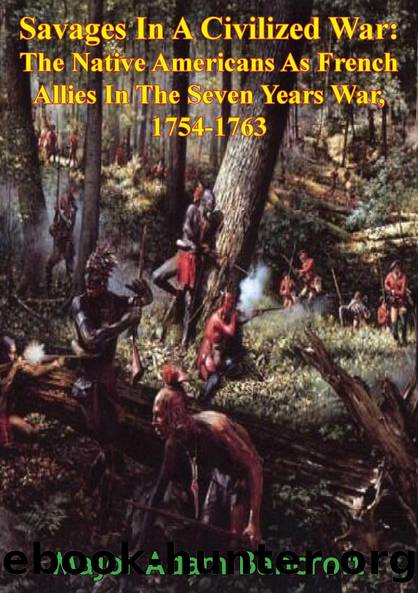Savages In A Civilized War: The Native Americans As French Allies In The Seven Years War, 1754-1763 by Major Adam Bancroft

Author:Major Adam Bancroft [Bancroft, Major Adam]
Language: eng
Format: epub
Tags: History, Military, Wars & Conflicts (Other), United States, 20th Century, Civil War Period (1850-1877)
ISBN: 9781782899570
Google: DaRvCwAAQBAJ
Publisher: Pickle Partners Publishing
Published: 2015-11-06T02:58:41+00:00
CHAPTER 5 â A FAILURE TO UNDERSTAND
âI am obligated in humanity, to desire you to surrender your Fort. I have yet in my power to restrain the savages, and oblige them to observe capitulation, as hitherto none of them have been killed, which will not be in my power in other circumstances.â{272} â Lieutenant-General Louis-Joseph de Montcalm, Relief Is Greatly Wanted
The fall and spring of 1757-1758 proved to be turning point in the French and Indian War. It was not, however, the decisive point that the French and Canadians sought. Though the French army under Montcalm and French guerrilla fighters using Vaudreuilâs strategy would achieve stunning victories at Fort William Henry and Fort Carollin in New York, the year proved to mark the beginning of the end of Franceâs reign in North America. This point of tipping point was not due to losses on the battlefield. Indeed, the early part of 1758 proved to be a banner year for the French and their Indian allies. It was this latter factor, the Indian allies that proved to be the undoing of Franceâs chances to stall the British enough to sue for a peaceful settlement.{273}
For the campaign season of 1758 through the end of the war, the Indians that Vaudreuil and the Canadians put their faith in to match the overwhelming resources of British North America, failed to turn out in the large numbers as they had in the previous years. When the 1759 campaign started, the Canadians were augmented with only 1,800 Indian warriors to combat the British invasion by both irregular and regular means.{274} This is compared to over 2,000 Indians who, drawn by French victories and gifts, assisted in just the battle for Fort William Henry in 1757.{275} It is estimated that at one point, the Indians of the Ohio Valley and the pays dâen haut were a pool of over 16,000 Indian warriors the French could call upon. Without the augmentation of Indians, the British maintained a 2:1 advantage over the French, and more importantly, the war increasingly became Europeanized, and the British drove the French from North America.{276}
The French, separate from the Canadians, had a general misunderstanding and dislike of Indian culture and their way of war by Montcalm and the French officers of the Troupe de Terre possessed this dislike. Montcalmâs general disdain grew from his first major campaigns in 1756, and was clearly shown in his reaction to the âmassacreâ of British prisoners at Fort William Henry in 1757. This one incident was the turning point for the Indians and the French alliance.{277}
The most prominent reasons the French lost the robust support of their Indian allies was the continued negative reaction to Indian actions and their style of warfare. The most famous was Montcalmâs acceptance of the surrender of Fort William Henry, New York, in 1757 and his reaction to the massacre of the British soldiers and camp followers by his Indian allies after the fortâs surrender. This was the main event that resulted in
Download
This site does not store any files on its server. We only index and link to content provided by other sites. Please contact the content providers to delete copyright contents if any and email us, we'll remove relevant links or contents immediately.
In Cold Blood by Truman Capote(3311)
The Innovators: How a Group of Hackers, Geniuses, and Geeks Created the Digital Revolution by Walter Isaacson(2846)
Steve Jobs by Walter Isaacson(2836)
All the President's Men by Carl Bernstein & Bob Woodward(2329)
Lonely Planet New York City by Lonely Planet(2172)
And the Band Played On by Randy Shilts(2131)
The Room Where It Happened by John Bolton;(2104)
The Poisoner's Handbook by Deborah Blum(2093)
The Murder of Marilyn Monroe by Jay Margolis(2059)
The Innovators by Walter Isaacson(2056)
Lincoln by David Herbert Donald(1945)
A Colony in a Nation by Chris Hayes(1881)
Under the Banner of Heaven: A Story of Violent Faith by Jon Krakauer(1750)
Amelia Earhart by Doris L. Rich(1650)
The Unsettlers by Mark Sundeen(1647)
Being George Washington by Beck Glenn(1623)
Birdmen by Lawrence Goldstone(1621)
Dirt by Bill Buford(1612)
Zeitoun by Dave Eggers(1593)
